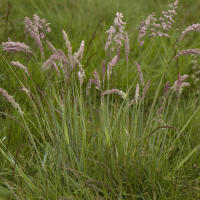Yorkshire fog grass
Holcus lanatus
Holcus lanatus, commonly known as Yorkshire Fog or Velvet Grass, is a grass species native to Europe and Asia. It is a perennial grass that is widespread and often found in grasslands, meadows, and disturbed areas. Here's an informative description:
Description:
-
Plant Structure:
- Height: Yorkshire Fog typically grows to a height of 30 to 100 centimeters.
- Growth Form: It has a tufted growth habit, with stems rising from a base.
-
Leaves:
- Leaf Arrangement: Leaves are alternate and have a distinctive rolled vernation.
- Texture: The leaves are broad, soft, and often covered with fine hairs, giving them a velvety appearance.
-
Inflorescence:
- Flowering Stems: Yorkshire Fog produces open, nodding flower heads on tall stems.
- Flower Spikelets: The flower spikelets are arranged in a loose, nodding panicle.
-
Color:
- Foliage: The leaves can vary in color, ranging from green to purple, and the flowering stems may take on a reddish tint.
Identification:
- Velvety Leaves: The velvety texture of the leaves is a distinctive feature.
- Nodding Flower Heads: The loose, nodding flower heads on tall stems are characteristic.
Ecological Role:
- Habitat: Yorkshire Fog is commonly found in a variety of habitats, including grasslands, meadows, and disturbed areas.
- Soil Stabilization: It can contribute to soil stabilization due to its extensive root system.
Cultural Uses:
- Ornamental Planting: In some regions, Yorkshire Fog is cultivated as an ornamental grass for its soft texture and attractive appearance.
Management:
- Pasture Grass: It is often used as a forage grass for livestock.
- Mowing: Regular mowing can help manage its height and prevent it from becoming too dominant in lawns or pastures.
Note: While Yorkshire Fog has certain benefits, it is important to manage its growth, as it can become invasive in certain situations.








